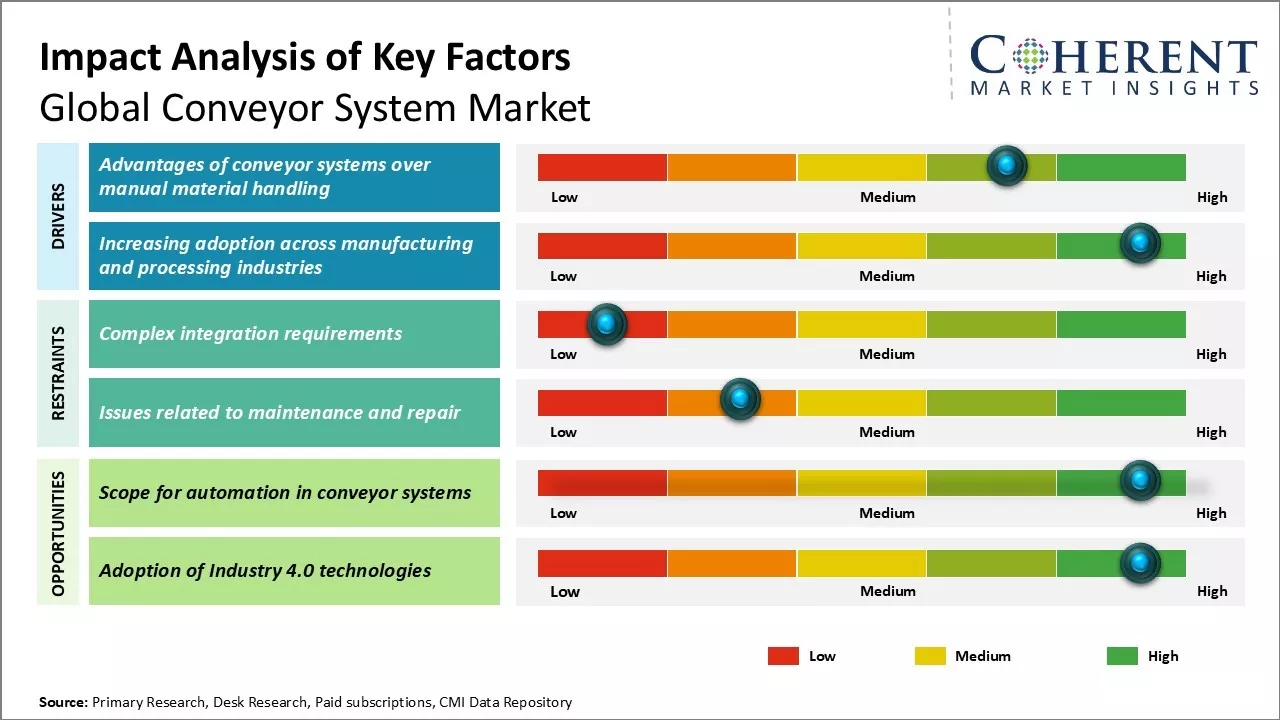Conveyor System Market Size and Trends
The conveyor system market is estimated to be valued at USD 10.94 Billion in 2025 and is expected to reach USD 16.14 Billion by 2032, exhibiting a compound annual growth rate (CAGR) of 5.7% from 2025 to 2032.
Key Takeaways of the Conveyor System Market
- By type, belt conveyor systems segment is estimated to contribute the highest market share of 41.8% in 2025.
- By vertical, the manufacturing segment is estimated to contribute the highest market share of 38% in 2025.
- North America remains the dominant player in the conveyor system market and is estimated to account for 40.6% of the global market share in 2025.
- Asia Pacific region is expected to emerge as the fastest growing market for conveyor system across the globe.
Market Overview

To learn more about this report, Download Free Sample
Rapid industrialization and automation across industries have boosted the demand for conveyor systems in material handling processes. Furthermore, growing e-commerce sector has also boosted the installation of conveyor systems in warehouses and distribution centers. Various industries like food & beverage, airport authorities, and e-commerce are investing in automated conveyor systems to improve productivity and efficiency.
However, stringent environmental regulations concerning noise, emissions, and energy consumption necessitate the development of eco-friendly conveyor solutions.
Market Concentration and Competitive Landscape

To learn more about this report, Download Free Sample
- The conveyor system market is moderately consolidated, with key players like Bastian Solutions, Inc., BEUMER Group GmbH & Co. KG, Caterpillar Inc., Continental Conveyor, and Daifuku Co., Ltd. holding significant market share. These companies lead through advanced automation technologies, extensive product portfolios, and strong global distribution networks. Dematic Corp., Dürr AG, and Emerson Electric Co. are particularly influential in integrating conveyor systems with broader industrial automation solutions, serving diverse sectors such as logistics, manufacturing, and mining.
- While leading suppliers offer comprehensive conveyor solutions across various industries, regional and specialized players such as Fives Group, Interroll Group, Kardex Group, and Kuka AG (Swisslog Holding AG) focus on niche applications like material handling components, robotics integration, and automated storage systems. Murata Machinery, Ltd., Siemens AG, and SSI Schäfer AG emphasize digitalization and Industry 4.0 capabilities, driving innovation through smart conveyor technologies and IoT-enabled solutions.
Current Events and their Impact on the Conveyor System Market
|
Current Events |
Description and its impact |
|
Technological Advancements and Industry 4.0 Integration |
|
|
Regional Infrastructure and Industrial Developments |
|
Uncover macros and micros vetted on 75+ parameters: Get instant access to report
Market Trends
Increasing Adoption across Manufacturing and Processing Industries
Conveyor systems have emerged as an indispensable material handling solution across diversified industrial verticals. Growing complexity of manufacturing and assembly processes have boosted the demand for automated movement of materials within premises. Automotive, food & beverage, packaging, pharmaceutical and other sectors are witnessing increased integration of conveyor belts, roller tracks and sortation systems.
For instance, CSTRANS flexible conveyor systems revolutionize food production lines, operating at speeds up to 50 m/min with 4,000 N tensile strength. A nut packaging plant in Shenzhen reduced product damage rates from 3.2% to 0.5%, saving nearly USD 140,000 annually. Maintenance costs plummet by 66%+ due to modular components and minimal downtime, boosting line availability from 87% to 98%. This highlights the growing demand for agile, high-efficiency conveyor solutions in food processing, where speed, precision, and reduced operational costs directly impact profitability and product quality.
Advantages of Conveyor Systems over Manual Material Handling
Conveyor systems have significantly impacted industries by reducing their dependency on manual labor for material movement tasks. While manual handling has its place, conveyor technology allows for higher throughput, improved safety and better optimization of workforce. Constant manual movement of materials involves significant costs associated with labor along with higher risks of injuries.
For instance, a study by Industrial Bearing & Transmission Industrial Solutions which stated that augers, AKA screw conveyors, can be more compact and are suitable for enclosed spaces or vertical transport. Augers can handle a much steeper incline (35 or 40-degree inclines) and have a much smaller space footprint compared to belt conveyors. This makes augers a preferred choice in facilities where space optimization and vertical conveying are critical to operational efficiency.
Conveyor System Market Insights by Type: Versatility and Scalability Boosts the Demand for Belt Conveyor Systems
Based on type, the belt conveyor systems segment is estimated to contribute the highest market share of 41.8% in 2025, due to their versatility and scalability.
Belt conveyors can be easily customized for specific production needs through adjustments to belt width, speed, incline angle, and number of transfer points. Their modular design allows sections to be added or removed with relative ease, enabling belt conveyors to scale along with production capacity changes. This flexibility reduces capital investment risks associated with unpredictable demand fluctuations.
Conveyor System Market Insights by Vertical: Focus on Efficiency and Safety Boosts the Manufacturing Sector
By vertical, the manufacturing segment is estimated to contribute the highest market share of 38% in 2025, due to concerns around efficiency and workplace safety.
Precise conveyance of parts and components is essential for achieving high levels of quality, consistency and ergonomic work practices demanded within modern manufacturing facilities. Systems like belt, roller and overhead conveyors transfer loads accurately and gently between machinery with negligible risk of damage.
Emerging Innovations in the Conveyor System Market
- Smart Conveyor Systems: IoT and AI Integration
Application: Integrating Internet of Things (IoT) and AI-driven sensors is revolutionizing conveyor systems. Real-time smart sensor monitoring ensures predictive maintenance, allowing operators to fix issues before costly breakdowns occur.
Example: In June 2025, Conveyor, a San Francisco-based startup founded by Chas Ballew, raised a USD 20 million Series B round led by SignalFire, bringing its total funding to USD 40 million. The investment supports Conveyor’s mission to eliminate sales-related friction by advancing the development of its AI-powered agents.
- Eco-Friendly Conveyor Belt Materials
Application: Sustainability is a major driver in industrial innovation. Conveyor belts made from recycled materials, bio-based polymers, and low-carbon production processes are gaining traction.
Example: Habasit and Fenner Dunlop are pioneering eco-friendly conveyor belts made from recycled plastics and natural rubber alternatives. Fenner Dunlop Conveyor Belting are pioneering a radical change of thinking with their ground-breaking single and dual-ply X Series.
AI Impacts on the Conveyor System Market
There is significant potential for optimizing conveyor system operations with the integration of Artificial Intelligence (AI) technologies.
- Machine learning algorithms optimize conveyor speed and load distribution in real-time, enhancing throughput by 15-20% while minimizing energy consumption. In addition, AI-powered predictive maintenance models analyze sensor data to forecast conveyor component failures, reducing unplanned downtime by up to 30% and lowering maintenance costs.
- AI-integrated vision inspection systems improve product quality by detecting defects and misalignments on conveyor lines with accuracy exceeding 98%. Intelligent control systems enable dynamic adjustment of conveyor operations based on workflow demands, boosting operational flexibility and reducing wear and tear.
Regional Insights

To learn more about this report, Download Free Sample
North America Conveyor System Market Analysis and Trends
North America has been the dominant region in the global conveyor system market with an estimated market share of 40.6% in 2025. The large-scale presence of prominent automotive OEMs as well as other manufacturing industries such as food and beverage, mining, and airport logistics has boosted the demand for conveyor systems in the region.
For instance, in March 2025, Bastian Solutions incorporated the business of viastore in North America to strengthen material handling equipment services as part of the Toyota Automated Logistics Group. Viastore North America, now part of Bastian Solutions, designs, engineers, and implements automated storage and retrieval systems (ASRS), conveyor systems and robotics to enhance inventory management, order fulfilment and overall operational efficiency.
Asia Pacific Conveyor System Market Analysis and Trends
The Asia Pacific region has emerged as the fastest growing market for conveyor system globally. Rapid industrialization and growing manufacturing sectors, especially in China, India, Vietnam and Indonesia can drive the market growth. These countries are also attractive manufacturing destinations for industries shifting their production bases from other mature markets.
For instance, NTPC's Pakri Barwadih coal mining project has made operational a 21-kilometre-long conveyor belt system to transport coal to Hazaribag railway station. The conveyor belt is Asia's longest and represented a significant advancement in coal transportation infrastructure.
U.S. Conveyor System Market Analysis and Trends
The U.S. is the dominant player in the North America conveyor system market, driven by its advanced manufacturing infrastructure, large-scale warehousing operations, and widespread adoption of automation in logistics.
For instance, as per WRC West River Conveyors, many mining operations treat conveyor belts as commodities, industry leaders recognize that the right belt selection can: Reduce unplanned downtime by up to 70%, extend service intervals by 30-50%, decrease energy consumption by 15-25%, improve safety metrics and compliance, and significantly boost bottom-line profitability.
Major industries such as automotive, food & beverage, and e-commerce are key users of conveyor systems, with companies like Amazon, Ford, and General Mills heavily investing in smart material handling technologies.
Canada Conveyor System Market Analysis and Trends
Canadian facilities are investing in flexible and modular conveyors to cope with seasonal fluctuations and labor shortages. The push toward warehouse automation, particularly in Ontario and British Columbia, has increased the demand for high-efficiency conveyor systems.
Moreover, government incentives promoting digital transformation in manufacturing are encouraging small and mid-sized enterprises to adopt AI-powered and sensor-integrated conveyor systems. Companies like Interroll and Fives Group have a growing footprint in the Canadian market, supporting customized, energy-efficient conveyor installations.
China Conveyor System Market Analysis and Trends
China is the largest and fastest-growing market in the region due to its massive manufacturing sector and rapid growth in e-commerce and logistics. The expansion of smart warehouses by giants like Alibaba and JD.com has accelerated the demand for automated conveyor systems.
Moreover, government initiatives under “Made in China 2025” are pushing industries toward automation, further fueling demand. Domestic manufacturers are increasingly investing in AI-integrated and IoT-enabled conveyors, while international firms like Siemens and Interroll are expanding their footprint to serve China’s scale-driven and cost-sensitive market.
Japan Conveyor System Market Analysis and Trends
Japan is a leading force in the Asia Pacific conveyor system market, driven by its high-tech manufacturing base and early adoption of industrial automation. With industries such as automotive, electronics, and logistics demanding precision and efficiency, Japanese companies rely heavily on advanced conveyor technologies.
Key players like Daifuku Co., Ltd. and Murata Machinery, Ltd. are headquartered in Japan, offering highly customized and integrated material handling systems. Japan’s focus on robotics, smart factories, and Industry 4.0 has positioned it as a technological leader in conveyor innovation, particularly in space-saving and high-speed systems.
Pricing Analysis of the Conveyor System Market
- System Type Drives Pricing:
- Belt conveyors typically range from USD 5,000 to USD 30,000, depending on length, width, and motor type. In contrast, automated or pallet-handling conveyors can exceed USD 100,000 due to higher load capacity and integrated controls.
- Level of Automation Significantly Impacts Cost:
- Manual or semi-automated conveyor systems are significantly cheaper, while fully automated systems with AI and IoT integration can be 30–50% more expensive, justified by labor savings and throughput gains.
- Material and Component Selection:
- Systems built with stainless steel (common in food and pharma) cost more—up to 25–40% higher than mild steel—due to hygiene and corrosion resistance requirements.
- Regional Variations:
- Pricing differs by geography—systems in North America and Western Europe are often 10–20% more expensive due to higher labor and compliance costs compared to systems sold in India or Southeast Asia.
- Operational Lifecycle Costs:
- While low-cost systems may offer short-term savings, high-end systems with predictive maintenance features reduce total cost of ownership (TCO) by up to 30% over 10 years through reduced downtime and part replacements.
Market Report Scope
Conveyor System Market Report Coverage
| Report Coverage | Details | ||
|---|---|---|---|
| Base Year: | 2024 | Market Size in 2025: | USD 10.94 Bn |
| Historical Data for: | 2020 To 2024 | Forecast Period: | 2025 To 2032 |
| Forecast Period 2025 to 2032 CAGR: | 5.7% | 2032 Value Projection: | USD 16.14 Bn |
| Geographies covered: |
|
||
| Segments covered: |
|
||
| Companies covered: |
Bastian Solutions, Inc., BEUMER Group GmbH & Co. KG, Caterpillar Inc., Continental Conveyor, Daifuku Co., Ltd., Dematic Corp., Dürr AG, Emerson Electric Co., Fives Group, Interroll Group, Kardex Group, Kuka AG (Swisslog Holding AG), Murata Machinery, Ltd., Siemens AG, SSI Schäfer AG |
||
| Growth Drivers: |
|
||
| Restraints & Challenges: |
|
||
Uncover macros and micros vetted on 75+ parameters: Get instant access to report
Electric Vehicle Transmission Industry News
- In 2025, Bastian's expertly designed conveyor systems replaced manual transport processes to create more reliable, ergonomic and organized operations. Conveyors can help automate a variety of processes, including transporting, sorting, loading, unloading, palletizing, order fulfillment and more.
- In May 2025, Continental launched total conveyance solutions with customer event as it celebrates expansion of conveyor belt plant in Brazil. The two-day event featured a ribbon-cutting ceremony and welcomed approximately 100 guests, including customers, industry professionals and local leaders.
- In February 2025, Daifuku, the global leader in material handling solutions, unveiled its latest advancements at ProMat 2025, the premier supply chain event, at McCormick Place in Chicago. Key technologies highlighted at the booth include, Conveyor and Structural Systems: Showcasing modular, flexible designs for seamless operational efficiency.
- In March 2025, INTERROLL, the world's leading provider of material handling solutions, heralding a paradigm shift in automated conveyor systems. With MCP PLAY, conveyor systems can be implemented more easily and quickly, operated more cost-effectively and energy-efficiently, and achieve up to 100% higher throughput.
Analyst View
- The conveyor system market is undergoing a structural transformation, not merely due to automation trends, but because of a decisive shift in operational priorities from cost-cutting to throughput maximization and downtime elimination. In my view, legacy conveyor setups are becoming operational bottlenecks, especially in high-volume industries like e-commerce, food processing, and automotive.
- Critically, the biggest misstep buyers make is underestimating Total Cost of Ownership (TCO). Companies opting for low-cost conveyors often face 3X more unplanned downtime, according to a 2024 study by Fives Group. In contrast, firms investing in high-end systems with predictive maintenance—like Siemens’ AI-powered SIRIUS ACT-enabled conveyors—report uptime levels exceeding 98%. The operational ROI here is non-negotiable, especially when a single hour of downtime in an automotive plant can cost upwards of USD 100,000.
- Moreover, the market is witnessing a convergence of robotics and conveyor technologies. To illustrate, Swisslog is deploying robotic-integrated conveyor lines in pharmaceutical distribution centers, cutting labor needs by over 40% and accelerating pick-pack cycles by 35%. In my opinion, companies that view conveyors as “static infrastructure” rather than dynamic, intelligent systems will be priced out of competitive logistics and production networks within the next five years.
Market Segmentation
- Type Insights (Revenue, USD Bn, 2020 - 2032)
- Belt Conveyor Systems
- Roller Conveyor Systems
- Overhead Conveyor Systems
- Pallet Conveyor Systems
- Others (e.g. Vibrating Conveyor, Bucket Conveyor)
- Vertical Insights (Revenue, USD Bn, 2020 - 2032)
- Manufacturing
- Logistics and Warehousing
- Food and Beverage
- Mining and Minerals
- Others
- Regional Insights (Revenue, USD Bn, 2020 - 2032)
- North America
- U.S.
- Canada
- Latin America
- Brazil
- Argentina
- Mexico
- Rest of Latin America
- Europe
- Germany
- U.K.
- Spain
- France
- Italy
- Russia
- Rest of Europe
- Asia Pacific
- China
- India
- Japan
- Australia
- South Korea
- ASEAN
- Rest of Asia Pacific
- Middle East
- GCC Countries
- Israel
- Rest of Middle East
- Africa
- South Africa
- North Africa
- Central Africa
- North America
- Key Players Insights
- Bastian Solutions, Inc.
- BEUMER Group GmbH & Co. KG
- Caterpillar Inc.
- Continental Conveyor
- Daifuku Co., Ltd.
- Dematic Corp.
- Dürr AG
- Emerson Electric Co.
- Fives Group
- Interroll Group
- Kardex Group
- Kuka AG (Swisslog Holding AG)
- Murata Machinery, Ltd.
- Siemens AG
- SSI Schäfer AG
Sources
Stakeholders:
- Manufacturing and Logistics Companies
- Warehouse and Plant Operations Managers
- Procurement and Supply Chain Heads
- Regulatory and Safety Bodies
Magazines:
- Material Handling & Logistics Magazine
- Modern Materials Handling
- Conveyor & Sortation Systems Magazine
- Industry Today
- Others
Journals
- International Journal of Advanced Manufacturing Technology
- Journal of Materials Processing Technology
- Automation in Construction
- Others
Secondary Sources:
- Company websites, annual reports, and investor presentations
- Industry publications and technical whitepapers
- Government databases and trade portals (e.g., U.S. Department of Commerce, Eurostat, Japan Ministry of Economy, Trade and Industry)
- Association publications (e.g., MHI – Material Handling Industry, CEMA – Conveyor Equipment Manufacturers Association)
- Technical standards and safety guidelines (e.g., ISO 5048, OSHA conveyor safety standards)
- News articles, industry journals, and press releases relevant to smart factories and warehouse automation.
Proprietary Elements:
- CMI Data Analytics Tool – Conveyor System Market
- CMI Existing Repository of Information for the Last 8 Years
*Definition: Global Conveyor System Market consists of companies that manufacture and supply conveyor belt systems used for transporting materials over short or long distances in various industries like food processing, healthcare, airport luggage handling, parcel sorting, and manufacturing. Conveyor systems allow for efficient transport of products, packages, components and waste without much manual labor.
Share
Share
About Author
Ramprasad Bhute is a Senior Research Consultant with over 6 years of experience in market research and business consulting. He manages consulting and market research projects centered on go-to-market strategy, opportunity analysis, competitive landscape, and market size estimation and forecasting. He also advises clients on identifying and targeting absolute opportunities to penetrate untapped markets.
Missing comfort of reading report in your local language? Find your preferred language :
Transform your Strategy with Exclusive Trending Reports :
Frequently Asked Questions
EXISTING CLIENTELE
Joining thousands of companies around the world committed to making the Excellent Business Solutions.
View All Our Clients

